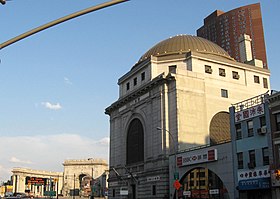Canal Street (Manhattan)

The Canal Street ( dt. : Canal Street ) is a main road in the south of New York City's District Manhattan .
location
Canal Street crosses Lower Manhattan and opens up New Jersey to the west via the Holland Tunnel and to the east Brooklyn via the Manhattan Bridge and Interstate 78 . It is the northern limit of the Tribeca district and the southern limit of the SoHo district . Canal Street also forms the backbone of Chinatown and is also the border with Little Italy .
history
The name Canal Street refers to an actual canal that was built here in the early 19th century to divert Collect Pond into the Hudson River .
The Collect Pond (or Fresh Water Pond ) was initially a pond and fresh water reservoir that was fed by its own spring. Then, when local craftsmen , breweries, firms and butchers dumped their waste into the Collect Pond, it became a source of infection and disease , making it necessary to build the canal. After the canal was completed, the pond was replenished in 1811, which made this area of Manhattan even more marshy, as there were many natural springs here that could no longer drain anywhere. Canal Street was completed in 1820 and followed the winding path of the canal.
The historic townhouses and apartment buildings that were being built along Canal Street quickly fell into disrepair. The eastern part of Canal Street was in the vicinity of the notorious Five Points slum , so the property values near this slum were significantly lower and the living conditions were much worse.
In the early 20th century, the jewelery trade was located around Canal Street and the Bowery , but moved to 47th Street, now the Diamond District, in the middle of the century . In the 1920s, Citizens Savings Bank built its headquarters on Canal Street in the Bowery, overlooking Manhattan Bridge Plaza, which is now a landmark in the area. After Radio Row closed in the 1960s, the Sixth Avenue section was New York City's main electrical equipment hub for over 25 years.
Today Canal Street is a busy shopping area, full of shops and street vendors to the west and banks and jewelry stores to the east. Many tourists and residents are out and about here every day, using the food stalls and simple shops that sell perfume, handbags, hardware, etc. at very reasonable prices. Often these things are gray imports or cheap imitations of branded products (electronics, clothing, accessories) that are sold as originals - sometimes in back rooms. Black-made DVDs and CDs are illegally sold on improvised stands, from suitcases, or on spread blankets. Even regular police raids cannot prevent this.
Individual evidence
- ^ "New Bank Building; Citizens Savings Bank to Erect Monumental Structure on Bowery," July 2, 1922, New York Times.
- ↑ "City Agents Shut Down 32 Vendors of Fake Items," Christine Hauser, February 27, 2008, New York Times.
- ↑ http://www.nytimes.com/2010/01/17/opinion/17kalman.html
Web links
- Canal Street map and info
- Photographs of buildings and shops along Canal Street.
- Virtual walk along Canal Street
Coordinates: 40 ° 43 ′ 5 ″ N , 74 ° 0 ′ 0.2 ″ W.

